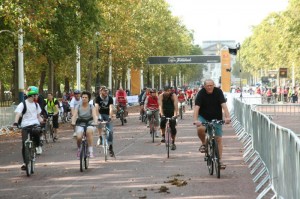Doubtless, the 2012 athletes will be provided with excellent tracks. But will the cycle paths used to reach the Olympic path be of a decent standard? Maybe.
London had a ‘Cycle to Work Week’ c1974 and I decided to take part. Since then, I have been a regular London cyclist. It felt like pioneering to begin with but cycle usage in the capital has been increasing steadily. Official policy on cycling has also changed and now appears to be as follows:
- Appoint platoons of cycle planning officers to commission regiments of consultants on cycle planning.
- Include cyclist-friendly policies in local plans (UDPs)
- Proliferate signs to mark the London Cycle Network (LCN)
- Paint any unwanted patches of roadspace green and call them cycle routes
- Ignore routes which are popular with cyclists
- Spend as little money as possible on cycle routes
- Use traffic calming devices, known as chicanes, to kill and maim as many cyclists as possible.
- Introduce bendy busses, described as ‘public transport’, to mop up survirors and make London safe, once again, for vehicles powered by the infernal combustion engine.
So, on the whole, I am lack optimism about the legacy of the London Olympics including a single high-quality cycle route. There are only two reasons for optimism: London’s Mayor (Boris Johnson) and the present leader of the Tory Party (David Cameron) are both keen cyclists. But so was a former Minister of Transport (Sir George Younger) and he managed to achieve nothing of value.
In order to make cycle routes useful and beautiful, cycle route planning and design should be taken out of the hands of transport engineers. The job should be done by landscape architects – but only those who are themselves cyclists.


Absolutely. Safe, beautiful, direct AND dedicated!
The roads were built for cars, so what do people try to get around with?.. cars. And what happens when everyone buys cars?.. we need more roads. Its a vicious circle that in my mind can only be stopped before it starts by designing the roads for bicycles in the first place.
You can’t change the London road network all at once but I’d like to see a stab at a serious conversion trial..
Large sections of the Old Kent Road are 3 lanes in each direction! I would love to see one of these lanes dedicated to bicycles. A lane not seperated from cars with green paint, but with a wall not even a bendy bus could get though!
http://maps.google.co.uk/maps?f=q&hl=en&geocode=&q=new+kent+road&sll=51.478912,-0.055031&sspn=0.000892,0.002674&ie=UTF8&t=h&ll=51.483995,-0.066122&spn=0.000892,0.002674&z=19
The old ‘streets’ in the City of London were built for pedestrians and horses, not automobiles, and their scale is much better suited to cycling than are the post-eighteenth century ‘carriageways’ which we now call roads. So it would be a great idea to start by converting the narrow streets in the City to non-automative use. It is amazing how many more cyclists and cycle shops there were in The City in 2008 than in 1998.
BTW: ‘Street’ comes from the Latin stenare (to lay down or pave) and ‘road’ from the Old English rad (raid, riding, hostile incursion). So, being fair, London should have a mix of streets and roads. They should be designed in different ways and managed by different agencies.
The new routes could be easily and cheaply supplement with the canal path routes. The existing canal path routes are overcrowded and need attention to the ruts and bumps but are other wise ready made to get to Stratford without cars and fumes.
The main issue is the narrow points and the bridges where a simple steel platform erected over the water would widen the route to allow simultaneous two way traffic. The canals are barely used by boats and the occasional narrowing of the canal would cause no issues.